What to feed baby kittens 1 week old
1 Week Old Kitten Info | How Long do Kittens Sleep
Want a side-by-side comparison of kittens as they grow? Visit our Kitten Progression: At-a-Glance guide or download the poster.Characteristics
| Weight: | 210-240 grams/7.4-8.5 ounces |
|---|---|
| Teeth: | No teeth |
| Eyes: | May start to open |
| Ears: | May start to unfold |
| Other: | Smaller than your hand |
Behavior
At about seven days old, kittens’ ears will unfold and their eyes may start to open, though their eyesight is still unfocused. They have doubled their birth weight to around eight ounces.
Kittens are becoming more aware of their surroundings, but they will huddle together for warmth and comfort and rarely venture far from their mother, their nest, or each other. They still sleep most of the time.
Care
Neonatalnewborn to four-week-oldkittens require round-the-clock care.
Feeding:
Use specific kitten bottles to feed the kittens with kitten formula. Make sure you never feed kittens “Cat Milk,” which is designed for adult cats, or cow’s or goat’s milk, which could give the kittens life-threatening diarrhea. Stick to kitten formula, such as kitten milk replacer (KMR), which can be purchased at most pet supply stores. Use specific kitten bottles to feed them kitten formula.
Feed kittens on their stomachsnot their backs like human babiesand tilt the bottle. After they’re done eating, you’ll need to burp the kittens. Put them on your shoulder or on their stomachs and pat them gently until they burp. For more information on what to feed kittens, visit Caring for Neonatal Kittens.
Feeding frequency:
Until they are 10 days old, they should be fed every two hours, round-the-clock. Once kittens are older than 10 days, they can eat every three to four hours.
Dehydration:
Dehydration is one of the biggest threats to kittens, along with chilling. Signs of dehydration include limpness, unresponsiveness, sunken eyes, and lethargy. You can also check by pulling up the skin at the scruff of the neck when the kitten is in a standing position. If the skin does not return to resting position quickly, the kitten is dehydrated.
Bedding (keep neonatal kittens warm):
Neonatal kittens can’t control their own body temperature until they are at least three weeks old and get cold easily, which can be life-threatening. From the moment you find them, keep the kittens warm and watch out for signs of chilling (i.e., listlessness and cool to the touch) and hold off on bottle feeding until the kittens have completely warmed up.
If you have nothing else on hand, use your own body heat to warm up a cold kitten, and rub her gently to aid circulation. Keep kittens warm by building a soft nest, like a box with a blanket and Snuggle Safe or a heated rice sock or water bottle. Make sure that kittens have room to move away from the heat if they want.
Make sure that kittens have room to move away from the heat if they want.
Cleaning:
Clean kittens using a warm, damp washcloth after they’re done eating. A kitten can chill if wet, so never submerge kittens in water. If a kitten needs to be cleaned up, wash only certain parts of her body with a washcloth. Be sure to always fully dry kittens with a hair dryer (on low and held far away enough not to burn) and towel.
Bathroom habits:
Kittens younger than four weeks old must be stimulated to go to the bathroom after each feeding. A mother cat uses her tongue to do this, but you can use a warm and damp cotton ball, tissue, or washcloth to gently rub the kitten’s anal area. Completely solid feces usually will not form while kittens are drinking formula. If you notice the kittens are having trouble urinating or defecating, consult a veterinarian.
A healthy kitten will urinate almost every time you stimulate them and have a bowel movement once or twice a day.
For more on caring for kittens younger than four weeks old, including health concerns, go to Caring for Neonatal Kittens.
Socialization
Handle the kittens often at this age to encourage their social development. This helps them connect positive experiences with people, which will help to adopt them into new homes. Once kittens are about three or four weeks old, they will start to play and playing will become an important part of socialization. For more about socializing kittens, go to alleycat.org/Socialization.
Want a side-by-side comparison of kittens as they grow? Visit our Kitten Progression: At-a-Glance guide or download the poster.
Newborn Kitten Care Week by Week — K&H Pet Products
Share:June 16, 2021 Samantha Johnson
Your new kittens have arrived, and even though the mother cat did most of the work, you still have things to do.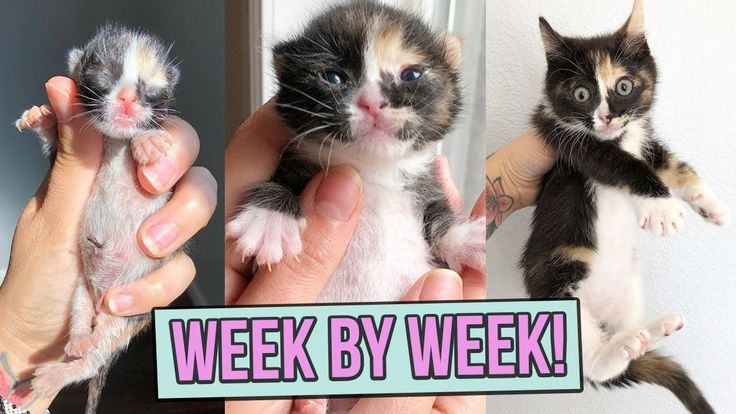 Before long, those helpless kittens with closed eyes and ears will be enthusiastic bundles of energy. In the meantime, you'll need to guide them through their first weeks of life.
Before long, those helpless kittens with closed eyes and ears will be enthusiastic bundles of energy. In the meantime, you'll need to guide them through their first weeks of life.
If your kittens have a healthy and loving mother cat, they'll rely on her to perform much of the important early work. You'll help out and provide valuable care, but you'll stay out of mom's way as she cares for the litter. Or, you might find yourself with a litter of kittens whose mother cannot care for them for some reason. In that case, you'll be responsible for additional care. Either way, here is a basic outline of newborn kitten care, week by week:
1-week-old kitten care
- Make sure they nurse early and keep at it! For the first three to four weeks, your kittens won't eat any solid food and will receive all of their energy and nutrition from nursing.1 The exact timing is up to mom and the kittens, but you should check to make sure the litter is nursing regularly, and there aren't any problems with the mother's ability to feed her kittens.

- Or bottle-feed every three hours. On the other hand, you may be wondering how to take care of a newborn kitten without a mother. If this is the case, you'll need to use a kitten-safe formula (not cow's milk), and bottle-feed the kittens every two to four hours. Ensuring the kittens receive proper nutrition is a key element of newborn kitten care, whether they're nursing or being bottle-fed.
- Provide a heat source. Your cat is warm, fluffy, and cuddly, and she'll use all of these traits when caring for her kittens. The newborn litter benefits greatly from her warmth, as they aren't able to effectively control their own body temperatures during their first few weeks. But what happens when the mother cat leaves the kittens for a time? A kitten-safe heated pad with an automatic thermostat can help keep the kittens warm without becoming too hot. You may also need to supplement the blanket-lined nest box area with a safe environmental heat source.
 If there is no mother cat present, aim for an ambient temperature of about 90°F.
If there is no mother cat present, aim for an ambient temperature of about 90°F. - Weigh the kittens. You don't want to handle the kittens too much at this stage, but weighing them daily will help you monitor their health and growth. Healthy kittens grow incredibly fast! (If it bothers the mother cat when you handle the kittens, you may need advice from your veterinarian before proceeding.)
- Clean the nest. You want to keep the nest area clean and change the absorbent bedding materials as often as needed.
2-week-old kitten care
- Begin a deworming regimen. Talk with your vet about deworming your kittens and get a deworming schedule from them.
- Eyes open. Your kittens' eyes should probably be open by now. If they're not open by around day 10, you can try gently wiping the lids clean and applying a bit of petroleum jelly.2 If their eyes are still closed at two weeks, your veterinarian should check them out.
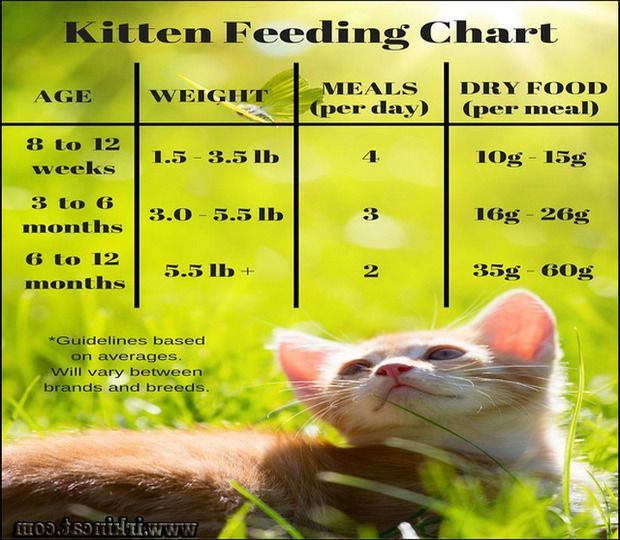
- Turn down the heat. You can lower the air temperature of the nest box to about 80°F.
3-week-old kitten care
- Offer a litter box. Until they're about three weeks old, kittens require the aid of their mother (or human caregivers, if they're orphaned)3 to encourage them to relieve themselves. But at around three weeks old, the kittens begin controlling their own potty breaks successfully. Now is the time to place a kitten-safe litter box in their environment. No need to specifically "train" the kittens; they should get the idea on their own.4
- Scale back the bottle feeding frequency. If you're bottle-feeding the kittens, you can probably stretch them out to four to six hours between meals.
4-week-old kitten care
- Socialize! It's important kittens become used to being around and handled by people at this stage. Carefully handle the kittens and get them used to brief periods of human interaction; this goes a long way toward helping them grow up to be people-friendly cats.
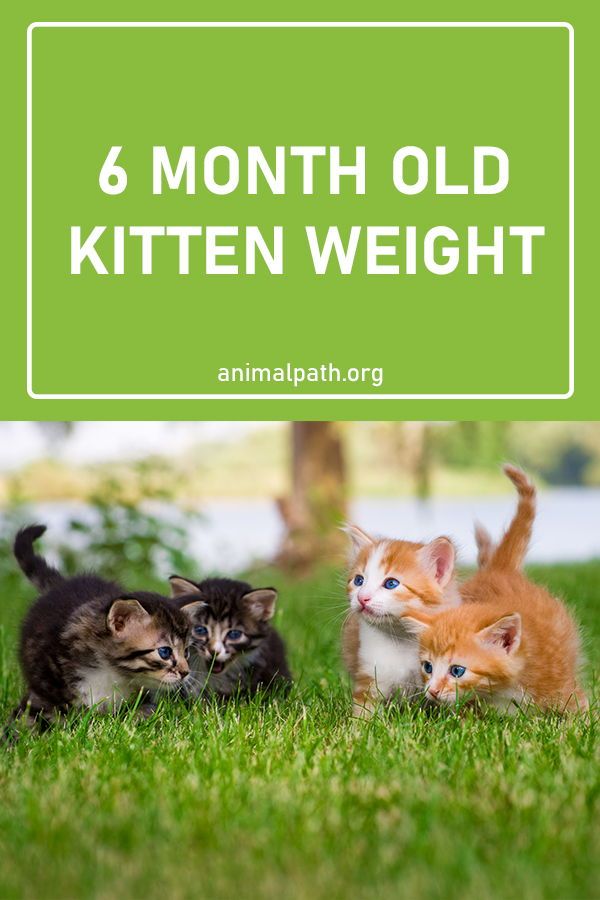 You might try introducing the kittens to new sounds too.
You might try introducing the kittens to new sounds too. - Room temperature. At this stage, the nest box ambient temperature can be lowered to about 75°F.
5-week-old kitten care
- Bring on the solid food! Time to start weaning the kittens. If you're bottle-feeding, you'll handle the timing;5 otherwise, the mother cat will naturally begin the process. What should you feed a newborn kitten? You can start by offering the kittens a combination of solid kitten food mixed with kitten formula. Or, try simply soaking kitten food in water until it's very soft. (Check with your vet for solid-food-to-formula ratios.)
- Water, too. When the kittens begin weaning and transition over to solid food, it's a good time to offer them water in a kitten-safe bowl too.
6-, 7-, and 8-week-old kitten care (and beyond!)
- Vaccination time! Talk to your vet about when your kittens can begin receiving their immunizations.
 Vaccinations don't take place all in one day; it's a process that continues for several weeks and requires a few visits to the veterinarian.
Vaccinations don't take place all in one day; it's a process that continues for several weeks and requires a few visits to the veterinarian. - Playtime! Your older kittens may enjoy playing with a fun toy or two. Some stimulating play will help them develop into healthy, capable cats. Supplying a cat scratcher isn't a bad idea either.
- Full meals. Your kittens may not be fully weaned yet, but they're able to eat larger amounts of high-protein kitten food, spaced out four times a day.
- Registration. Purebred kittens should be registered with their appropriate breed association. Hopefully, it won't go to their heads!
- Saying goodbye. By 12 weeks old, your kittens may leave for their new homes. To help ease the transition, supply them with a pillow that mimics the sound of their mother's heartbeat. This can help give kittens the familiar feeling of their mother and littermates even in their new home.
 You can also mimic the warmth of the litter with a heated kitty bed.
You can also mimic the warmth of the litter with a heated kitty bed.
The week-by-week care of newborn kittens may be a lot of work, but the process is filled with satisfaction and enjoyment as you help to raise the kittens. Good luck!
1. WebMD. "Newborn Kitten Care," 16 February 2021. https://pets.webmd.com/cats/guide/default.htm
2. Animal Humane Society. "Caring for young kittens and their moms." https://www.animalhumanesociety.org/health/caring-young-kittens-and-their-moms
3. Shelter Medicine School of Veterinary Medicine. "Guide to Raising Underage Kittens." University of Wisconsin-Madison University School of Veterinary Medicine. https://www.uwsheltermedicine.com/library/guidebooks/guide-to-raising-underage-kittens/caring-for-kittens-from-birth-to-eight-weeks
4. KittenLady.org. "Litter Training." http://www.kittenlady.org/litter
5. Shelter Medicine School of Veterinary Medicine. https://www.uwsheltermedicine.com/library/guidebooks/guide-to-raising-underage-kittens/caring-for-kittens-from-birth-to-eight-weeks
Share: Previous article Keeping Newborn Kittens Warm Next article What Temperature Is Too Hot for Cats?How to feed a kitten | Pick a Friend Foundation
1.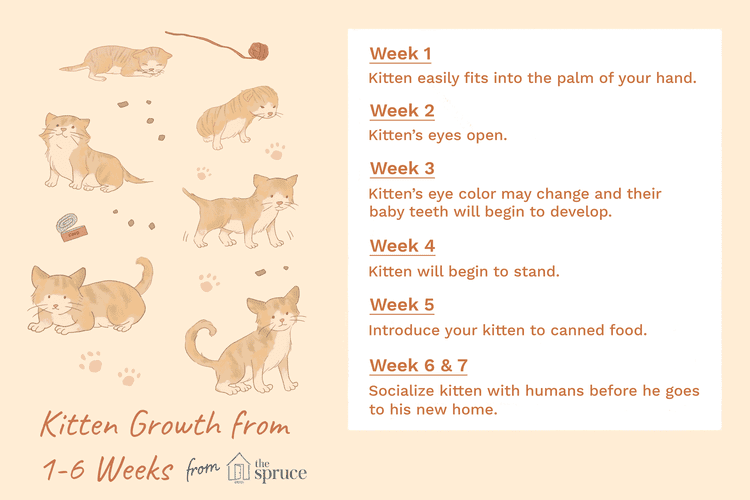 Gather the necessary supplies. To feed a newborn kitten, you will need some kind of specially designed device. If possible, use a bottle with a kitty teat set, such as Hartz. This bottle itself is small and made of transparent plastic with markings for more accurate measurement of liquids. The nipple is made of special rubber and has an appropriate comfortable shape to fit in the kitten's mouth. This allows him to suckle the bottle as if he were suckling his mother. nine0005
Gather the necessary supplies. To feed a newborn kitten, you will need some kind of specially designed device. If possible, use a bottle with a kitty teat set, such as Hartz. This bottle itself is small and made of transparent plastic with markings for more accurate measurement of liquids. The nipple is made of special rubber and has an appropriate comfortable shape to fit in the kitten's mouth. This allows him to suckle the bottle as if he were suckling his mother. nine0005
If you don't have a dedicated feeding device, then another alternative is a syringe that can be used to dribble milk into the kitten's mouth. However, the kitten does not have the ability to suck on a syringe, so try to find a suitable replacement as soon as possible.
2. Sterilize the equipment. It is critical to maintain sterile equipment. A simple wash is not enough for this. Consider using a steam sterilizer (like for baby bottles) or immerse the equipment in a bowl of cold sterilizing liquid, such as Chicco. nine0005
nine0005
Cold sterilization fluid can usually be found in pharmacies in the children's section. Follow the instructions on the packaging. If you decide to use such a liquid when sterilizing your kitten's feeding equipment, do not forget to rinse everything with boiled water afterwards so that there are no residues of the sterilizing agent on the inventory.
3. Prepare and heat the mixture. If you are using liquid formula, open the jar and measure out the required amount of mixture according to the instructions. When using a powder mixture, follow the instructions on the packaging regarding the required number of scoops per volume of water. Always follow the directions exactly, as a mixture that is too strong can lead to stomach upset, while a formula that is too dilute will not provide the kitten with the required amount of nutrients. nine0005
Always prepare a fresh batch of formula for every feeding. The mixture does not contain preservatives, and the immune system of a newborn kitten is still weak, so getting bacteria from the environment into the milk can be a disaster for his health.
Do not microwave; because of this, too hot and too cold areas can form in the mixture. Instead, simply place the mixture in a container and place it in hot water to heat up. nine0008
Make sure the milk is at the right temperature – neither too hot nor too cold. Ideally, the mixture should be at body temperature, so when you apply a couple of drops of it to the back of your hand, their temperature should seem to be about the temperature of your skin. If you use too hot mixture, you can burn the kitten's mouth.
4. Check your kitten's body temperature. When you are ready to feed your kitten, make sure it is warm. To some extent, a kitten's ability to digest food depends on its body temperature. If the kitten is cool, his digestion will slow down, and the mixture will linger in the stomach and ferment. Newborn kittens usually cling closely to their mother and therefore remain quite warm. For the first three weeks of their life, a temperature of about 35. 6-37.8 degrees will be considered ideal. nine0005
6-37.8 degrees will be considered ideal. nine0005
Try to keep the kitten at this temperature by placing a heating pad under a well-insulated kitten nest. If you don't have a heating pad, use a hot water bottle wrapped in a towel to prevent the kitten from coming into direct contact with the hot water and getting burned. Refresh the hot water as needed to keep the kitten warm.
5. Feed the kitten. Sit in a comfortable chair with a folded towel on your lap. Place the kitten in the same way as it would be fed by its mother: lay it on its stomach with its paws down and with its head slightly raised. The first time you try to feed the kitten, squeeze a drop of the mixture onto the tip of the nipple or syringe. Bring it very close to the kitten's mouth. The kitten has a rather acute sense of smell and, most likely, having smelled milk, he will try to kiss the nipple or syringe. nine0005
When using the pacifier at this stage, you should help the kitten a little by inserting it into its open mouth. Natural instincts should take over and the kitten should start suckling.
Natural instincts should take over and the kitten should start suckling.
When using the syringe, gently press the plunger to release a drop of milk into the kitten's mouth. Let the kitten swallow between drops. Never fill your mouth with milk completely, as the kitten can inhale the milk, it will enter the lungs and develop pneumonia, which is usually fatal for kittens. Just take your time and go slowly. nine0008
The position of the kitten is very important. Never feed it upside down like a human baby and make sure the kitten is lying on its stomach during feeding. Make sure that his head is not up, as this can lead to inhalation of the mixture into the lungs, which is very dangerous and can lead to the death of the kitten.
6. Feed your kitten the correct amount of formula. Kitten formulas are usually accompanied by instructions on how much and how often to feed. Follow these instructions. The following are only generalized indications of the volume and frequency of feeding mixtures of kittens in the first weeks of their life.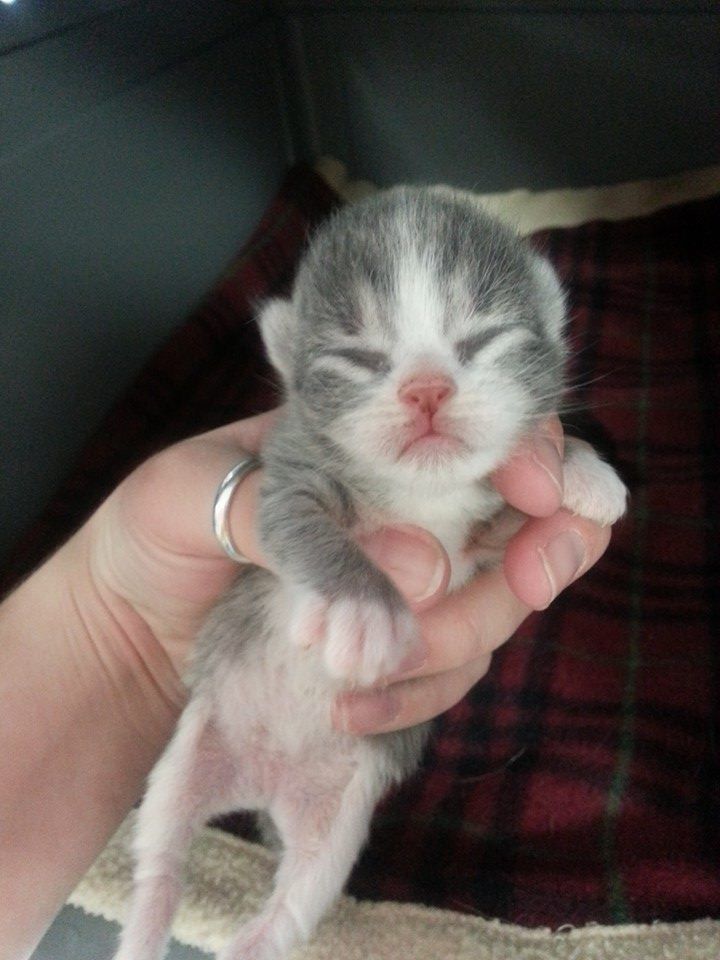 nine0005
nine0005
At the age of 1-3 days, give 2.5 ml of cat's milk replacer every two hours.
At the age of 4-7 days, give 5 ml of the mixture and organize 10-12 feedings per day.
At the age of 6-10 days, give 5-7.5 ml of the mixture and organize 10 feedings per day.
At the age of 11-14 days, give 10-12.5 mixtures and feed the kittens every three hours.
At the age of 15-21 days, give 10 ml of the mixture 8 times a day. At the age of over 21 days, give 7.5-25 ml 3-4 times a day simultaneously with the introduction of solid food. nine0008
7. Pay attention to important signs while feeding your kitten.
When learning and practicing formula feeding a kitten, remember that improper feeding can lead to breathing problems. Make sure that milk does not flow out of his nose during feeding, and his stomach does not swell.
In terms of feeding volumes, if your kitten is greedy enough to continue sucking on the pacifier even after exceeding the recommended dose, examine his belly. If it swells up and becomes tight, stop feeding. This is a sign of a full stomach, it's just that the kitten hasn't realized it yet. Don't overfeed him. nine0008
If it swells up and becomes tight, stop feeding. This is a sign of a full stomach, it's just that the kitten hasn't realized it yet. Don't overfeed him. nine0008
If your kitten eats less than the recommended amount, don't panic. This may be his personality. If you're worried about your kitten being malnourished, instead of trying to force more formula into him at the risk of choking his lungs, stop, let the kitten rest, and try feeding the kitten again in about an hour.
8. Remain calm. It is very important not to lose patience and remain calm when you feed the kitten so that he is also calm. In addition, allow the kitten to eat as long as he needs to avoid overeating or digestive problems. nine0005
Stimulate burping by placing the kitten's back against your body and stroking its belly. When a cat cares for kittens, she licks them and thereby stimulates urination and defecation. Don't be surprised by any of the possible results - these are good signs!
9. Clean the kitten's bottom. The mother cat usually licks the kittens' bottoms and genitals immediately after feedings to stimulate urination and defecation. She also eats their excrement, which is a natural way to keep the nest clean, as a dirty nest can attract predators. In the absence of the mother, you need to intervene in this process. Take a damp cotton swab and wipe the kitten's anal area, imitating licking movements. As soon as the kitten goes to the toilet, wipe off the excrement with a cotton swab. Finish the procedure with an additional wipe of the kitten's buttocks with a clean cotton swab, and you will be free until the next feeding. nine0005
Clean the kitten's bottom. The mother cat usually licks the kittens' bottoms and genitals immediately after feedings to stimulate urination and defecation. She also eats their excrement, which is a natural way to keep the nest clean, as a dirty nest can attract predators. In the absence of the mother, you need to intervene in this process. Take a damp cotton swab and wipe the kitten's anal area, imitating licking movements. As soon as the kitten goes to the toilet, wipe off the excrement with a cotton swab. Finish the procedure with an additional wipe of the kitten's buttocks with a clean cotton swab, and you will be free until the next feeding. nine0005
This is an important step in the successful feeding of a kitten. If the mother's stimulation of urination and defecation is not imitated, the kitten will not empty its bladder and bowels normally, which can cause it to become seriously ill.
10. Return the kitten to its warm nest or box to rest.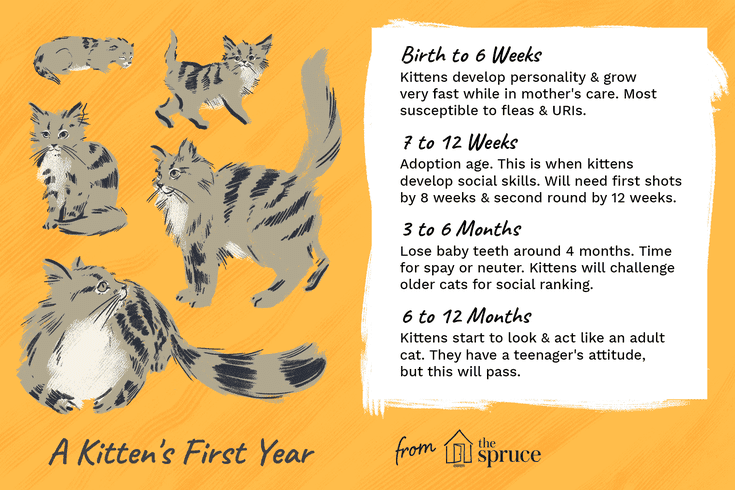 Continue to follow a regular daily feeding schedule for the coming weeks until weaning and proper transition to solid foods. Additionally, consult your veterinarian regarding a suitable diet at the time of weaning. nine0005
Continue to follow a regular daily feeding schedule for the coming weeks until weaning and proper transition to solid foods. Additionally, consult your veterinarian regarding a suitable diet at the time of weaning. nine0005
Introduce solid foods in the form of soft canned food and solid kibble when the kitten is about four weeks old. Some kittens prefer to bottle feed for up to eight weeks, so the progress of the transition to solid food should be monitored by a professional veterinarian.
How to properly feed a newborn kitten | Hill's
Cats have a strong maternal instinct, but sometimes your furry pet doesn't want to feed her offspring or can't do it due to objective reasons. If you don't manage to give the kittens to another lactating cat, you will have to try on the role of a mother and feed them yourself. How to do it right? nine0005
How to feed a kitten
First of all, you need to buy a special mixture for feeding newborn kittens in a pet store. The composition of such mixtures is almost identical to mother cat's milk, rich in amino acids and does not cause digestive problems in kittens.
The composition of such mixtures is almost identical to mother cat's milk, rich in amino acids and does not cause digestive problems in kittens.
Do not feed kittens with cow's milk - it is very different in composition from cat's milk and can lead not only to diarrhea, but also to more serious health problems.
How to choose a syringe
You can purchase a special feeding syringe from a veterinary pharmacy. If you didn’t manage to buy such a syringe, you can use an ordinary plastic syringe with a rubber nozzle, after removing the needle from it. nine0029
Be sure to practice squeezing the mixture out of the syringe. Feed should come in small drops so that the kitten does not choke.
How to properly feed a kitten
When feeding a kitten with a syringe, follow the following steps:
-
before feeding, the kitten's tummy should be massaged a little to stimulate digestion;
-
hold the kitten upright while feeding and squeeze the mixture from the syringe drop by drop onto the kitten's lower lip to allow the kitten to swallow the food; nine0005
-
after feeding, the newborn kitten should again massage the tummy to stimulate defecation (after about a week he will be able to do this without additional help).

Feed quantity and mixture temperature
How much food does a newborn kitten need? Adhere to the following approximate calculation:
-
in the first 5 days the kitten needs 30 ml of a special mixture per day, kittens should be fed every 2-3 hours; nine0005
-
from 6 to 14 days the amount of the mixture should be increased to 40 ml per day, the number of feedings is reduced to 8 times a day;
-
From day 15 to day 25, the amount of the mixture should reach 50 ml per day, kittens can already be fed only during the day, but at least 6 times.
The mixture must be fresh. Do not store the prepared mixture in the refrigerator for more than 6 hours.
Newborn kitten formula should be 36-38°C. The mixture should not be too hot or too cold. Before feeding, check the temperature of the formula by dropping it on your wrist. nine0005
Is the kitten full?
Finding out that the kitten has already eaten is very simple - little kittens fall asleep almost immediately after eating. If the kitten does not have enough food offered to him, he will continue to squeak, push and look for a pacifier.
If the kitten does not have enough food offered to him, he will continue to squeak, push and look for a pacifier.
Do not overfeed your pet. Newborn kittens do not yet have a developed digestive system, and too much food can disrupt the intestines, causing constipation or diarrhea.
Introduction of solid foods
From the age of about 3-4 weeks, the kitten can be introduced to solid food little by little. Portions of complementary foods should be small, about the size of a pea. In no case do not offer the kitten raw meat or fish - they may contain parasites. Also, do not give the kitten fried, fatty, salty, spicy foods and chocolate. nine0005
It is best to buy a specialized dry or wet cat food - its composition is properly balanced and rich in amino acids.
Before introducing complementary foods and if you have any questions about feeding and caring for a newborn kitten, be sure to consult your veterinarian. If you do not like something in the behavior of the kitten - he has no appetite, he is too lethargic, there is discharge from the nose or eyes - immediately visit a veterinary clinic.











